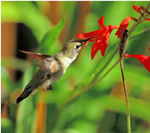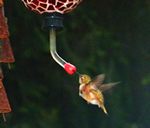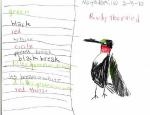Journey North News: Spring 2010
Posted Wednesdays: Feb. 3, 17,24, Mar. 3, 10, 17, 24, 31, Apr. 7, 14, 21, 28, May 5, 12, 19, 26, Jun 2, 9
When
you register (free), you can
receive these Hummingbird Migration News Updates via e-mail.

Fewer hummers at your feeder these days? Are these travelers really gone, or is something else at work? What do you think? Read what 3 experts think. Watch this season's hummingbird migration maps in action. What big ideas can you learn from them? Our expert shares his thoughts about the little migrants that reach the northern-most part of the breeding grounds. A BIG thank you for helping track hummers this spring! Photo: Ed Robertson

Celebrate the story of Sweet Pea in this week's slideshow. Find out about banding little hummers and what we can learn from this technique. How will the Gulf of Mexico oil spill affect the migration? And share your thoughts about the little migrants that reach the northern-most part of the breeding grounds.
Photo: Ed Robertson

More and more of you are reporting your first sighting of the year (FOY). Study the progress of both our species the past 6 weeks, then describe the migration patterns. This week's slideshow gives you a look at how the hummers prepare for the long journey back to their wintering grounds. Two videos of a hen hummer feeding her chicks help us celebrate a new generation of hummingbirds. Photo: Michael Berry

The ruby-throated hummingbird sightings continue to pour in and both species are filling up the map. Be sure to check it out. This week's slideshow takes you into a nest where the birds are ready to fledge. What does a hummingbird look like? Check out the new art gallery of hummer portraits created by grade 3 students in Decatur, Georgia.

Why are my hummingbirds late? That was the question people asked as cold temperatures swept across the north during the past week. Take a look into a hummingbird nest this week. A photographer shares the day-to-day images of tiny eggs and miniature babies. Photo: Dorothy Edgington

Good flying weather sent lots of rubythroats north this past week. Hummer expert, Lanny Chambers reports his first rubythroat 10 days later than average. He tells us his theory about this year's migration pattern. Learn about a vagrant sighting of a rufous in Maine. Play with words to describe baby hummers in the nest. Teachers can find some clues for year end assessments. Photo: Dorothy Edgington

Rufous hummingbirds are on the move into western Montana this week. One rufous even has a name; he's called "Glitterpants." Storms and rain caused a "fall out," and 89 new rubythroat sightings reported. High speed cameras allow us to learn new things about hummingbirds. A "Nature" video shows how. And what do you want to know about the hummingbird nesting cycle? Plug in to this important part of the hummingbird's life cycle. Photo: Ed Robertson

Rufous hummingbirds pushed further east this week into eastern Washington and Idaho. Are warmer temperatures pushing the migration faster this year? Compare two species: think how their differences and similarities affect their migrations. Earth Day is a good time to think about how to best care for the earth and its creatures, including hummingbirds! Photo: Bud Hensley

Ruby-throated hummers pushed further north this week and many more people got their first sighting. As the males arrive they appear to be on a manic mission: Set up territories, defend them from would-be thieves, and impress a mate. Watch their antics in this week's slideshow. Then solve the migration rate puzzle to determine how long before you see your first hummer.
Photos: Russ Thompson

This week was nothing short of amazing for the rubythroat migration. Strong southerly winds and mild weather took the birds north across 13 more boundaries and into Canada! The Costa Rica farm reported this week their last hummer of the season has left. Imagine flying these distances using their little wings. Learn more about their marvelous wings and how they are adapted to allow the hummingbirds to do what other birds cannot.Photo: Russ Thompson

Variable winds and rain brought little movement early last week. Winds from the south will bring more hummers and other migrants from the Tropics in the coming week. This week it's all about habitat. What kinds of sun-driven events need to take place before you can sustain a hummingbird? How far away are the hummers from your feeder? Use your map and math skills to predict when you'll see your first hummer. Photo: John Doerper

Photo: Cat Traylor
Southerly winds pushed the rubythroat migration into 4 new states this week. Observers throughout the Pacific Northwest continued to report loads of rufous activity. This week it's all about food. It's early in the migration, and many flowers are yet to bloom. What fuels the hungry hummers this time of year? Build your own feeder with recycled materials to hang in your classroom window or school yard. It is simple way to see a hummer up close.

Photo: Russ Thompson
A flush of new sighting reports—32 total rufous this week— yet it seems the rufous migration is holding at the 49th latitude. Learn about one of the hummer's most amazing adaptation - how they so efficiently drink nectar. Look at the differences in our 2 species migrations so far. Learn why they are so different. And keep your eyes on the wind and weather to predict what the migrations will do by next week.

Photo: D. Edington
A few days of southern winds and more ruby-throats have been spotted along the Gulf Coast. Traffic will slow down as a cold front brings rain this week. Most early hummingbird sightings are males. Find out why. Study a poster of pictures showing hummers doing various things. Observe them like a scientist. What do you wonder about hummingbirds? Save your questions and submit them to our expert starting Friday.

Photo: Russ Thompson
Just like clockwork, last week the first migrating ruby-throated hummingbirds showed up on US soil. However, the weather could cause a stall in the migration until winds shift from north to south later in the week. Will the south winds bring with them the first big numbers of rubythroats? How do ruby-throated hummingbirds get here? Let's dig into these questions and explore your ideas.

Sighters in the western states are seeing the first scattered rufous sightings, but we are still waiting for the first reports of ruby-throated hummingbirds. Keep your eye on the map for sightings along the Gulf Coast. How can weather maps help you predict when they will cross the Gulf? Here's one example of a map that might help. Learn about the geography of the migration as you make your own map to use this season.

Visit a tropical farm in Costa Rica where 9 species of hummingbirds can be found, including our ruby throat. What does the wintering grounds have to offer these migrating birds? Some hummers have been sighted in the north. Why this is happening? Use your imagination: send a postcard home from the wintering grounds-before migration starts.
Welcome to Journey North's 17th season! Meet and get to know our hummingbirds. We will be tracking the spring migration of the ruby-throated and rufous hummingbirds on their journey north this spring. Why do they come back north? Explore this question in this week's Update and slideshow.
Photo:M. Zinkova
We know at least three ruby-throated hummingbirds have reached their winter home in Costa Rica! Patricia Nethercote announced the news from her backyard in Guayabo de Bagaces, and she sent snapshots to prove it. Meanwhile, our migration maps show hummingbirds are going, going, and almost gone from Cananda and much of the United States. If you are still seeing hummingbirds, please let us know! Photo: Patricia Nethercote
Hummingbird
Migration Update: September 22, 2009
While
people in the north were saying their last goodbyes, hummingbird migration
reached a peak last week in the Gulf Coast states. Swarms of hungry hummingbirds
appeared in backyard feeders as they poured down from the north. Please
continue to report your hummingbird observations regularly. The goal of
our map is to show when and where hummingbirds were present this fall.
Photo:
Bill Morris





